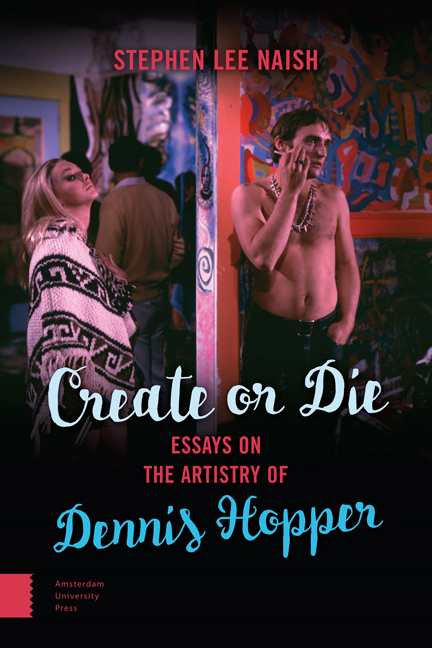Book contents
- Fronmatter
- Dedication
- Contents
- Introduction
- Scenes from a Revolutionary Life: How Dennis Hopper Conquered the American Century
- Hip-Hopp: Dennis Hopper and Music
- The Elephant in the Room: Dennis Hopper and American Politics
- Love and Hate: The Conflict of Emotions in The Blackout and Carried Away
- Commercial Breakdown: Dennis Hopper in the World of Advertisements
- White Light/White Heat: Actor and Character Collide in White Star
- Double Standards: The Art and Photography of Dennis Hopper
- Coda: The Fourth Wall
- Acknowledgements
- Notes
- Bibliography
Double Standards: The Art and Photography of Dennis Hopper
Published online by Cambridge University Press: 11 December 2020
- Fronmatter
- Dedication
- Contents
- Introduction
- Scenes from a Revolutionary Life: How Dennis Hopper Conquered the American Century
- Hip-Hopp: Dennis Hopper and Music
- The Elephant in the Room: Dennis Hopper and American Politics
- Love and Hate: The Conflict of Emotions in The Blackout and Carried Away
- Commercial Breakdown: Dennis Hopper in the World of Advertisements
- White Light/White Heat: Actor and Character Collide in White Star
- Double Standards: The Art and Photography of Dennis Hopper
- Coda: The Fourth Wall
- Acknowledgements
- Notes
- Bibliography
Summary
Dennis Hopper's last film appearance was in Belgian artist Nicolas Provost’s 22-minute short film Stardust (2010). The film featured Las Vegas cityscapes, busy street scenes, members of the public, and also celebrities being filmed unawares using a high-resolution digital camera. Provost then edited the footage to create a narrative using the language of Hollywood films. Provost recorded Hopper innocently talking in a McDonald's restaurant with fellow actor Danny Trejo. Their unheard dialogue is replaced with cliché gangster talk. Provost also captured Jack Nicholson leering at some girls as they pass him by in a Las Vegas night club. It is fitting that Hopper's last appearance on film would be in an artistic context. Running parallel to his decade-long regression in mainstream film and reliance on straight-to-DVD movies, Hopper faced a resurgence of interest in his artwork and photography. It is a fascinating paradox, in that Hopper's artistic expression in photography, painting, and sculpture is acknowledged as uncompromisingly passionate and raw, yet a majority of his film work in the last decade of his life would appear, at least at face value, to be the complete opposite.
An exhibition of his collected artwork entitled Dennis Hopper and the New Hollywood that went on display at The Cinémathèque Française in Paris collected together photographs, sculptures, found pieces, and screenings of his more revered film work. The exhibition moved on to the Australian Centre for the Moving Image in Melbourne. A coffee table book of the same name highlighting Hopper's own artwork, art collection, interviews, and musings on art and film was produced in conjunction with the exhibitions. Throughout the last decade, monographs of Hopper's photographic work and art pieces were also published to coincide with numerous exhibitions throughout the world. After his death in 2010, extensive and expensive tomes of his photography were published, most notably Dennis Hopper: Photographs 1961-1967 (Taschen 2009) and Dennis Hopper: The Lost Album (Prestal 2012), which coincided with a touring exhibition of photos and prints found tucked away in a drawer after Hopper's death. The more recently released monograph Dennis Hopper: Drugstore Camera (Damiani 2015) was a collection of improvised shots using cheap store-bought instamatic cameras that clearly illustrated Hopper's eye for candid photography.
- Type
- Chapter
- Information
- Create or DieEssays on the Artistry of Dennis Hopper, pp. 85 - 94Publisher: Amsterdam University PressPrint publication year: 2016



